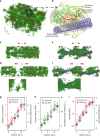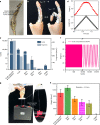A supertough electro-tendon based on spider silk composites
- PMID: 32165612
- PMCID: PMC7067870
- DOI: 10.1038/s41467-020-14988-5
A supertough electro-tendon based on spider silk composites
Abstract
Compared to transmission systems based on shafts and gears, tendon-driven systems offer a simpler and more dexterous way to transmit actuation force in robotic hands. However, current tendon fibers have low toughness and suffer from large friction, limiting the further development of tendon-driven robotic hands. Here, we report a super tough electro-tendon based on spider silk which has a toughness of 420 MJ/m3 and conductivity of 1,077 S/cm. The electro-tendon, mechanically toughened by single-wall carbon nanotubes (SWCNTs) and electrically enhanced by PEDOT:PSS, can withstand more than 40,000 bending-stretching cycles without changes in conductivity. Because the electro-tendon can simultaneously transmit signals and force from the sensing and actuating systems, we use it to replace the single functional tendon in humanoid robotic hand to perform grasping functions without additional wiring and circuit components. This material is expected to pave the way for the development of robots and various applications in advanced manufacturing and engineering.
Conflict of interest statement
The authors declare no competing interests.
Figures




References
-
- Okada T. Object-handling system for manual industry. IEEE Trans. Syst. Man Cybern. 1979;9:79–89. doi: 10.1109/TSMC.1979.4310152. - DOI
-
- Jacobsen, S., Iversen, E., Knutti, D., Johnson, R. & Biggers, K. Design of the Utah/MIT dextrous hand. In: Proceedings. 1986 IEEE International Conference on Robotics and Automation. IEEE (1986).
Publication types
MeSH terms
Substances
LinkOut - more resources
Full Text Sources

